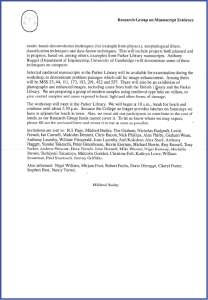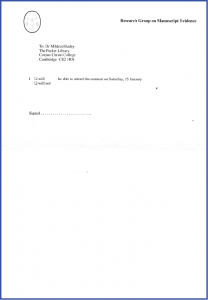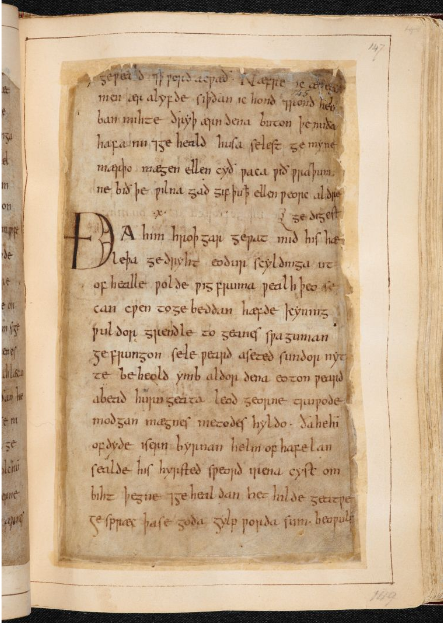Image-Processing and Manuscript Studies (January 1994)
January 1, 2014 in Events, Manuscript Studies, Photographic Exhibition, Reports
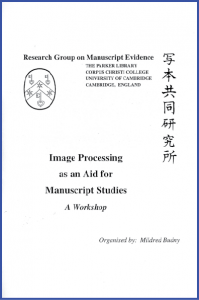 A one-day Workshop held
A one-day Workshop held
at the Parker Library of Corpus Christi College, Cambridge,
by the Research Group on Manuscript Evidence
15 January 1994
In the Series of Research Group Seminars on ‘The Evidence of Manuscripts’
The Parker Library, Corpus Christi College, Cambridge
[First published on 13 October 2015 from our Archives, with updates]
This workshop focused upon optical imaging techniques as aids for manuscript studies. It considered developments in imaging through photographic and computerised methods, as it provided a forum for information and feedback about techniques of image processing, both existing and planned: applications, capabilities, limitations, desiderata, and future potential. Participants included experts in manuscript studies, conservation, photography, imaging aids, computing, radio astronomy, engineering, forensics and medical imaging.
Our First Event Report in Booklet Form
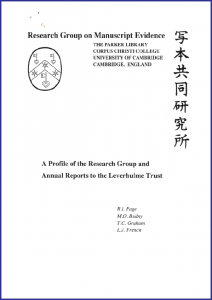 A ‘Preliminary Report’ of the proceedings of the Workshop was prepared and printed by the Research Group as a small-format Booklet soon after the event.
A ‘Preliminary Report’ of the proceedings of the Workshop was prepared and printed by the Research Group as a small-format Booklet soon after the event.
Following the move of our principal base to the United States later that year, not to the destination expected, but to Princeton, we thought that the Booklet had disappeared. Describing the event for our upgraded website (in October 2015), we had to rely on the corrected proof-copy, transcribed here. More recently, from another section of our Archives, the printed copy of the Booklet has emerged, and we publish it as well in downloadable form.
It represents the first of our printed Booklets for any of our events. It followed the model of our Annual Reports for the Research Project, composed principally by Mildred Budny and circulated in printed copies both individually and as a collected group, as described among our Publications). Those reports summarised our Seminars and Workshops, along with accounts of our other activities and the research work itself.
It also followed the model of the Exhibition Booklets for the exhibitions at the Parker Library of “Canterbury at Corpus” (1991) and “Matthew Parker in Cambridge” (1993), although those are illustrated with our photographs from Parker Library materials. Both were printed in-house and circulated at the events, as well as afterward. Both were reprinted, but in quarto format, in the Old English Newsletter, 24:4 (Summer 1991), Appendix A (= pages A-1–A-7) and 27:1 (Fall 1993), Apendix A (A-1–A-8); the latter issue is available online in the OEN Archives, but not yet the former. In their original design, these Exhibition Booklets emanated in A3 format as a group of single sheets stapled twice along the left-hand side; the 1991 Exhibition Booklet, with text and photographs by Mildred Budny, was also prepared as an A5 booklet of folded and nested leaves with the pages of text and image reduced to half-size in photocopying. Similar layout in small-format booklets came to pertain also to the Annual Reports. Such forms of in-house design, layout, and publication by the Research Group on Manuscript Evidence prepared precedents, and customs, for the Workshop Booklet.
Then, after the Research Project was completed and the Research Group moved to the New World, our scholarly Events mainly focused upon Symposia for some years. As our Annual Series of Symposia on “The Transmission of the Bible” gathered momentum, their Programs, with brief Abstracts of the Papers, grew from single or double-sided pages (1995, 1996, and 1997), and took the form of short booklets, as here:
- 1998 Symposium exterior
1998 Symposium interior - 1999 Symposium exterior
1999 Symposium interior - 2000 Symposium exterior
2000 Symposium interior
Those folded and unstapled booklets comprise either a double-sided 4-page unit (1 quarto sheet folded in half as a bifolium) or a menu-like tryptich (1 legal-size sheet folded in three) with wings to open and close at will. Each case was issued in printed form at the event and circulated afterward also in printed form. In this respect, the Symposium Booklets differ from the 1994 Imaging Seminar Report, which emerged after the event — indeed like the Annual Reports of our events overall (1990–1994). The 1994 “Preliminary Report” takes the form of 6 double-sided sheets folded into 12 pages as a small-format booklet (A5), although it also circulated as full-page sheets (A3).
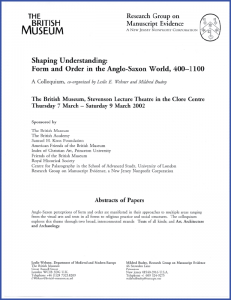
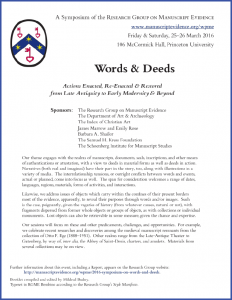 A longer booklet accompanied our 2002 Colloquium at the British Museum. That case stands within The New Series of our Seminars, Workshops, Colloquia & Symposia.
A longer booklet accompanied our 2002 Colloquium at the British Museum. That case stands within The New Series of our Seminars, Workshops, Colloquia & Symposia.
Within the New Series, the Booklets have become a regular, but not necessarily invariable, feature, while illustrations enter their pages more and more, through generous donations of images for the purposes. Our experience in designing, laying out, and typesetting our Illustrated Bulletin ShelfLife (2006–) prepared the way for the illustrated Booklets as a way of life.
Each case was issued in printed form at the event and circulated afterward also in printed form, until we acquired a website and the site could accommodate them. Our tradition is to “launch” the publication of the booklet in its printed form at the event itself. Then we may post it on the website and circulate it elsewhere.
More recent, and illustrated, examples of the booklets employ our copyright font Bembino. Issued in print at the event, as is the custom, they now appear on our site in downloadable form:
- 2013 Symposium on “Identity and Authenticity”
- 2014 Symposium on “Recollections of the Past”
- 2014 Colloquium on “When the Dust has Settled”
- 2015 Congress (“Predicting the Past”)
- 2016 Symposium on “Words & Deeds”
- 2016 Congress (“Crusading” and “Mirror”)
See also our list of Publications. The “Imaging” Booklet joins their company.
1. The Invitation to the “Imaging” Workshop
The Invitation appears here.
- Page 1, Page 2, and RSVP Form on view on this Page.
- Pdf version.
2. The Booklet
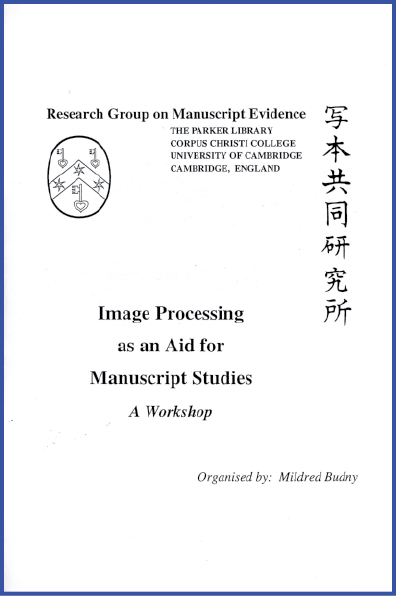 A Report of the Workshop was prepared for publication by the Research Group on Manuscript Evidence by Mildred Budny and Leslie French.
A Report of the Workshop was prepared for publication by the Research Group on Manuscript Evidence by Mildred Budny and Leslie French.
Designed as a 9-page, small-format Booklet, laid out in Adobe Garamond (the chosen official font for the Research Group at the time, as described in the early version of our Style Manifesto), it opens with a Front Cover and contains
- a Summary
- the Programme
- a Preliminary Report (with descriptions, as it were Abstracts, of the presentations)
- a List of Attendees, and
- an Appendix.
The Appendix describes the Research Group Visit to the British Library in December 1993 in preparation for the workshop.
[Now partly out of date, as described above:
The Booklet survives as a single proof-corrected printout in the archives of the Research Group on Manuscript Evidence. Its layout corresponds with the small-format booklets, set in Adobe Garamond, culminating the series of Annual Reports (1990‒1994) by the Research Group on Manuscript Evidence to the Leverhulme Trust (described in our Publications). The distribution of the booklet had to be limited, and then abandoned, soon after it had been completed, in the face of a series of challenges jeopardizing other, larger publications, as well as the future location of the Research Group.]
Here, as a record of the event, we publish the Preliminary Report, now transcribed on this website in our copyright font Bembino. The transcription incorporates the proof corrections and represents the printed form. For convenience of consultation, it combines two elements of the Booklet into a single component and includes within its span a list which appears in the Invitation (reproduced above).
That is, here we combine the list of presentations in the Programme with the descriptions of the presentations (a form of Abstracts) presented in the Preliminary Report. Also, we place the list of the first Invited participants (named in the Invitation) before the final List of Attendees, as a record of the momentum in gathering interest in the event as it took fuller shape. With permission from The British Library, we add images from the Beowulf Manuscript, now available online. We admire the appearance of the Electronic Beowulf, and savor its Welcome by our Associate, its major creator, Kevin Kiernan.
[Now partly out of date, with the recovery of the printed Booklet:
Although this Booklet did not have the good fortune of entering the world as a published entity in its time, years later, our process of surveying the archives and history of the Research Group on Manuscript Evidence on our updated website (2014–) led to the ‘recovery’ of this document. It seems worthwhile to present its record (with hindsight and foresight, and/or vice versa) within the context of our continuing exploration of viable ways to promote discourse between different disciplines and interests, and to present the fruits of those discussions in varying forms.]
Over the years, our developing practice of providing Abstracts of Papers/Presentations as part of the Announcement or Record of a given Event (Seminar, Workshop, Symposium, etc.) or Congress Session has taught the value of presenting brief (or maybe not-so-brief) descriptions of the presentations which provide some further information about the subject, its importance, and its context.
Call it a Menu, which might whet the appetite. These approaches are now recorded now throughout this website, for our Events and, more recently, for our Congress Activities.
*****
Starting here:
Image Processing
as an Aid for
Manuscript Studies
A Workshop
A one-day workshop held on 15 January 1994 at the
Parker Library, Corpus Christi College, Cambridge,
by the Research Group on Manuscript Evidence
Summary
Organized by Dr. Mildred Budny jointly with Dr. Leslie French, with the assistance of Dr. Graham Woan and Mr. A.E. Parker, this workshop focused upon optical imaging techniques as aids for manuscript studies. It considered developments in imaging through photographic and computerised methods. The workshop provided a forum for information and feedback about techniques of image processing, both existing and planned: applications, capabilities, limitations, desiderata, and future potential. Participants included experts in manuscript studies, conservation, photography, imaging aids, computing, radio astronomy, engineering, forensics and medical imaging.
Programme
Mildred Budny (Co-Director, Research Group on Manuscript Evidence)
“Manuscripts as a Focus for Image Processing”
Dr Budny reported the concerns to explore imaging aids by both the Leverhulme Trust Research Project on ‘The Archaeology of Anglo-Saxon Manuscripts’ and the larger Research Group on Manuscript Evidence, based at the Parker Library. She surveyed examples of problem passages which call for image enhancement: erasures, palimpsests, with one text written over another; burnt portions; liquid damage (notably ink lakes and liquid immersion); passages damaged by rust-burn marks and holes from binding mounts; pages obscured by exposure and rubbing while unbound; passages obscured by the application of chemical reagents; elements added or altered in different inks, sometimes spanning many centuries; drypoint glosses (especially occurring in superimposed layers); passages affected by corroded pigments or show-through from the opposite side of the leaf; offsets of ink and pigments from pages now lost; and multiple damage through a combination of features. The account considered examples from Corpus Christi College, MSS 12, 23, 44, 111, 173, 201 and 422; and British Library, Cotton MS Otho C. v.
Leslie French (Research Consultant, Research Group on Manuscript Evidence)
“Image Processing at the Parker Library”
Dr French reported the Research Group explorations of image-processing using contrast-enhancement and line-sharpening techniques. These included the results of his work of scanning and processing Dr Budny’s photographs of Corpus Christi College MSS 41 and 352; British Library photographs of the badly burnt Cotton MS Otho A. viii; and photographs of a set of fourteenth-century wax-tablets found at York. The processed images of MS 41 had been transmitted electronically to Binghamton University in New York, and published there [in the Old English Newsletter, 16:1 (Fall 992), pages 32–33]; images of MS 352 were manipulated interactively to show a new range of possibilities for imaging problems, as with show-through and offsets of lost portions; images of the wax-tablets were manipulated with different contrast levels and magnifications, yielding some improved readings, and images of the Cotton fragment were subjected to linear contrast alterations, with basic image-processing algorithms to record the series of manipulations. Dr French also reported his most recent work in applying Fourier-transform techniques to distinguish large-scale (low-frequency) features on a page from higher-frequency components representing script.
A.E. Parker (Senior Conservation Officer, Collection and Preservation Directorate, British Library)
“Imaging Equipment for Manuscripts and Documents”
Mr Parker surveyed the history and applications of examination equipment for deciphering manuscripts and documents available at the Manuscripts Conservation Studio of the Collection and Preservation Directorate of the British Library, and elsewhere. These include microscopes, boroscopes, Infra Red and Ultraviolet lighting, fibre-optic lighting, the Video Spectral Comparator (VSC), electro-luminiscent screens (or glow-panels), Electro-Static Detection Apparatus (ESDA) and colour closed-circuit television fittable to the optical devices, to produce photographs or video recordings.
Mr Parker’s examples of problems and solutions included the use of Infra Red light to reveal underdrawings, faded carbon-based inks (as in British Library Egerton MS 289); Ultraviolet light or the combination of the VSC/Image Integrator to enhance faint images of iron-tannate-based ink (in Cotton MS Otho A. viii) or obscured ink acid burns (in Cotton charters); the combination of the VSC/Image Integrator to reveal differences in inks (as in the British Library Visitors’ Book); the Electroluminscent screen of fibre-optic cables to locate underdrawings (as in Harley MS 2803); and microscopy and fibre-optic lighting to identify the sequence of layering of inks and pigments (as in fifteenth-century printing with gold); fibre-optic lighting to highlight impressions of lost or lifted materials or additions (as in Royal MS 6 E iv); and borescopy to reveal spine sewing patterns. Mr Parker also reported the results of the joint project, devoted to a problematic page in Cotton MS Claudius A. I, carried out at the Research Group visit to the British Library in December (see Appendix).
A.G. Filby (Head of Questioned Documents Section, Metropolitan Police Forensics Laboratory)
“Modern Forensic Developments and Forensic Limitations in Imaging”
Dr A. G. Filby considered modern forensic developments in imaging, as applied to documents and other materials, ranging from offsets of shoes to fingerprints. Developments include trace analysis, fluorescence/luminescence, ESDA (Electro-Static Detection Apparatus) and developing fingerprints. Dr Filby also considered the limitations of forensic work in these areas, including lack of background data, the need for records of treatment and alternation, the normal short time scale and problems of dating.
Malcolm Dennett (Keith Johnson & Pelling Ltd)
“Developments in Photographic Equipment and Film Emulsion Technology”
Mr M. Dennett surveyed devevlopments in photographic equipment and film emulsion technology, and their value for manuscript photography. He demonstrated techniques of copy-photography on site. He also reported on the development of Fujichrome 50, a new professional 50 ASA-rated film by Fuji Photo Film Co, which gives comparable results to Kodachrome, using standard E6 chemistry. This permits more precise control over the film-processing to improve consistency across exposures and lighting conditions. Mr Dennett also distributed film samples and data information.
Chris Bacon (Bowens Product Manager, Keith Johnson & Pelling Ltd)
“Advances in Lighting Equipment for Manuscript Photography”
Mr C. Bacon reported on developments in lighting techniques for photography of manuscripts, artefacts and works of art. He demonstrated on-site various techniques for reducing Ultraviolet light emission during photographic sessions. This included a new ‘soft-box’, developed in America, containing a correcting dispersion plate which both reduces UV transmission and improves illumination evenness.
Graham Woan (Radio Astronomy Department, Cavendish Laboratory, Cambridge University)
“Radio-Astronomical Techniques Applied to Manuscript Studies”
Dr Woan gave a radio-astronomical perspective on imaging problems in manuscripts, focusing upon how lessons learned from cleaning astronomical images obtained from radio telescopes might be applied to manuscript studies. He surveyed various techniques of image reconstruction, especially through Maximum Entropy. He discussed the limitations of these methods, which assume a uniform point-source distortion across the whole of the image, and discussed the requirement for ‘prior’ information to enable a realistic reconstruction, which becomes especially complex in fields of humanist studies. He also po9inted to the significant potential offered for imaging manuscripts by the Automatic Plate Measuring machine, a large and powerful flatbed scanner developed to digitize Schmitt Plates containing photographs of the sky. Dr Woan demonstrated examples derived from Dr Budny’s photographs of Corpus Christi College MS 173, using both this machine and other techniques at the Institute of Astronomy.
W.J. Fitzgerald (Engineering Department, Cambridge University)
“Image Processing at the Engineering Department, Cambridge University”
The Signal Processing and Communications Group of the Department of Engineering at the University of Cambridge reported on its work on image restoration od degraded audio and visual materials of various kinds.
Dr W.J. Fitzgerald gave an introduction to the work of this group. This covered both final-year undergraduate projects, where a single image might be subject to a standard set of techniques, through Ph.D student work treating sequences of images (for example degraded cinema-film stock) and post-doctoral research programmes, including the joint project with the British Library, of which Dr Lasenby is a member.
Joan Lasenby and Anthony Huggett (Engineering Department, Cambridge University)
“Techniques of Image Enhancement, Present and Future”
Dr J. Lasenby surveyed standard techniques of image-enhancement in various fields. These include contrast-enhancement, histogram equalization, adaptive histogram equalization and application of filters. She also reported on plans for future techniques, applying some model-based deconvolution techniques (for example from physics), morphological filters, classification techniques and data-fusion techniques. This included projects both planned and in progress, based on, among others, examples from Parker Library manuscripts and a new project shared with the British Library (Research Division). In parallel, Mr A.R. Huggett demonstrated some of these techniques on computer, including a range of image processing techniques applied to a passage in Corpus Christi College MS 422, which had been degraded following application of an ink-enhancer (chemical reagent) in the nineteenth century.
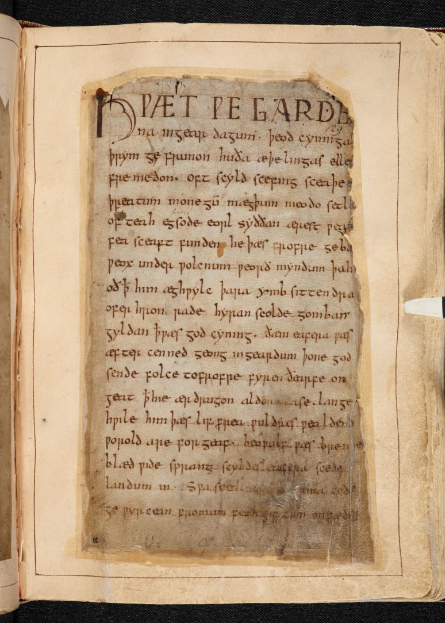
©The British Library Board, Cotton MS Vitellius A. XV, folio 132r. The opening of the epic poem ‘Beowulf’, setting the stage impressively for the sole surviving copy of this major monument of Old English language and literature. Reproduced by permission
Andrew Prescott (Department of Manuscripts, British Library) and
Kevin Kiernan (University of Kentucky at Lexingon)
“Digitisation, Restoration and Dissemination of Manuscripts”
Dr Prescott and Prof. K. Kiernan reported on the digitization, restoration and dissemination of manuscripts, notably in the project to prepare an electronic facsimile of the badly burnt Beowulf manuscript (British Library Cotton MS Vitellius A. xv [the digital facsimile was subsequently placed freely online.].
Dr Prescott displayed some preliminary results of the digitization for this project, and described the plans for their archival storage and access. Materials for his computer demonstration were electronically transferred on the day, with Dr French’s help, from Kentucky.
Prof. Kiernan demonstrated a Hypertextual application of the Beowulf material. Using a Macintosh computer, he showed how images, editions, commentary and text might be linked to form educational material at various levels.
Peter Greenhouse (Consultant for Sexual Health, Ipswich Hospital)
“Laproscopic Techniques for Manuscript Studies”
Mr P. Greenhouse reported on laproscopic techniques in medical imaging and their potential for manuscript studies. He demonstrated a video exploration of the interiors of the spines of printed books, revealing features of the backs of their quires, their sewings, their glue and their spine-liners reusing fragments of printed or manuscript leaves.
Exhibition of Photographs and Computer Images
The workshop was accompanied by an exhibition of photographs and enhanced images, including examples from both the British Library and the Parker Library. Prepared by Dr French, Dr Budny, and Mr Parker, it presented examples of problems and solutions to imaging manuscripts and documents in both centres.
Appendix
Organised by Dr Budny and Mr Parker, a Research Group visit to the British Library took place in December, in preparation for the workshop at the Parker Library in January. The meeting was attended by Dr French, Dr S.L. Keefer (Trent University, Ontario) and Mr R.M.Keefer (consultant specialist to the Alcan corporation, Canada).
Dr Prescott demonstrated developments in the new Digitisation Project at the British Library devoted to the Beowulf manuscript. Mr Parker surveyed the history, development, range and uses of advanced viewing aids in the Manuscripts Conservation Studio of the Collection and Preservation Directorate of the British Library, notably as applied to the Western Manuscript collection since the early 1970s. Mr Parker demonstrated uses of microscopy, borescopy, infrared and ultra-violet lighting, fibre-optic lighting and the Video Spectral Comparator (VSC), with examples from British Library materials.
Mr Parker and Dr Budny then conducted a joint project between the British Library and the Research Group. It was devoted to a problematic page selected by Dr Budny in Cotton MS Claudius A. iii, a collection of pontifical and other fragments mainly from Christ Church, Canterbury. Portions of the page, containing inscriptions, decoration and illustration, were examined under the VSC screen and under microscopy, using both indirect and transmitted lighting with cold fibre optic lighting and a glow-panel. Mr Parker took photographs for display in the January workshop. Dr Budny and Dr French recorded the day’s proceedings with both still and video cameras.
Attendees
1. Invited as the Plan began to Evolve
At first, as listed on the Invitation (shown above), invitations were sent to:
R.I. Page, Mildred Budny, Tim Graham, Nicholas Hadgraft, Leslie French, Ian Cannell, Malcolm Dennett, Chris Bacon, Nick Phillips, Alan Philby, Graham Woan, Anthony Lasenby, William Fitzgerald, Joan Lasenby, Anil Kokohan, Alex Stark, Anthony Hugget, Yusuke Takeuchi, Peter Greenhouse, Kevin Kiernan, Michael Borrie, Roy Russell, Tony Parker, Andrew Prescott, David French, John Bennett, Mike Weston, Nigel Ramsay, Michelle Brown, Toshiyuki Takamiya, Malcolm Godden, Christine Fell, Kathryn Lowe, William Stoneman, Paul Szarmach, Jeremy Griffiths.
As the preparations for the workshop advanced, more invitations arose as the interest increased. They are listed in the Report Booklet.
2. List of Attendees Reported in the Booklet
Chris Bacon (Keith Johnson & Pelling Ltd)
Richard Beadle (St John’s College, University of Cambridge)
John Bennett (British Library)
Mildred Budny (Research Group on Manuscript Evidence)
M.A.M. Daniels (Chemistry Department, University College London)
Malcolm Dennet (Keith Johnson & Pelling Ltd)
A.G. Filby (Questioned Documents Section, Metropolitan Police Forensics Laboratory)
W.J. Fitzgerald (Signal Processing and Communications Group, Engineering Department, University of Cambridge)
Leslie French (Research Group on Manuscript Evidence and Olivetti Research Ltd)
Timothy Graham (Research Goup on Manuscript Evidence)
Peter Greenhouse (Ipswich Hospital)
Michael Gullick (The Red Gull Press)
Anthony Huggett (Signal Processing and Communications Group, Engineering Department, University of Cambridge)
Kevin Kiernan (University of Kentucky at Lexington)
Anil C. Kohohan (Signal Processing and Engineering Group, University of Cambridge)
Joan Lasenby (Signal Processing and Engineering Group, University of Cambridge)
R.I. Page (Research Group on Manuscript Evidence)
A.E. Parker (Collection and Preservation Directorate, British Library)
Cheryl Porter (University College London)
Andrew Prescott (Department of Manuscripts, British Library)
Nigel Ramsay (Department of Manuscripts, British Library, and University of Kent at Canterbury)
Roy Russell (Collection and Preservation Directorate, British Library)
Alex Stark (Signal Processing and Engineering Group, University of Cambridge)
Paul E. Szarmach (Binghamton University and the Institute for Advanced Study, Princeton)
Toshiyuki Takamiya (Keio University, Tokyo, and St John’s College, Cambridge)
Yusuke Takeuchi (Signal Processing and Engineering Group, University of Cambridge, and Hitachi)
Graham Woan (Radio Astronomy Department, Cavendish Laboratory, University of Cambridge)
Dr Porter and Dr Daniels are members of the Leverhulme Trust Research Project on ‘Non-Destructive Pigment Analysis of Medieval Manuscripts by Raman-Spectroscopy’ at the Department of Chemistry, University College London.
*****
The Booklet itself appears here.
The next Seminar considered
“King Alfred and His Legacy”
(Faculty of English, University of Oxford, 29 April 1994)
First, however, there was a Visit or Workshop at the Parker Library on
“Pigment-Analysis of Corpus Manuscripts”
(Parker Library, 4 March 1994)
On that Visit, bringing members and equipment of the Research Project on “Non-Destructive Pigment Analysis” at U.C.L., there came 2 participants of the January Workshop: Cheryl Porter and Marcus Daniels.
The next Seminar at the Parker Library considered
“Marginalia in Manuscripts”
(Parker Library, June 1994)
*****
P.S. and P.P.S.
P.S. The Electronic Beowulf, edited by Kevin Kiernan, is now online. Hurray!
P.P.S. The transfer of computer images, via Kentucky, on the day of the Workshop for Andrew Prescott’s demonstration performed a service similar to “The First Network Transfer of Images in Anglo-Saxon Studies” [of 2 images from Corpus MS 41] reported in the Old English Newsletter, 26:1 (Fall 1992), 32–33, now online.
Come To Think Of It
Hindsight is Perfect. Especially with Images Included . . .
Maybe by now, “spoiled for choice” by the offerings of manuscript images in digital forms online, you might wonder “What’s the Big Deal?” And maybe, if you remember or imagine what it was like not to have them, or only to have a little bit of them, with much special efforts, skill, enthusiasm, and application (plus access to the manuscripts, let it not be forgotten), then you might think that those early days had some genuine excitement to them.
P.P.S. While we are reminiscing, we can take note that the WebMaster of the Research Group on Manuscript Evidence, Jesse Hurlbut, had experience and motivation in the early years of digital representation of manuscript images, also at the University of Kentucky, although we met him only afterward (at the 2004 International Congress on Medieval Studies), by which time he had long developed that experience and expertise more fully, generously, with such results already as DScriptorium and now with a beautiful website devoted to Manuscript Art — Taking a Closer Look. Oh yes, and with the Website of the Research Group on Manuscript Evidence, for which we give thanks.
We’ve come a long way, don’t you think? You/We Are Here.
*****


